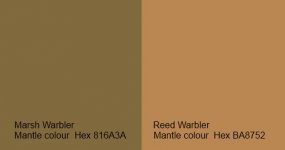Colour comparison.
Greetings,
I've been generating Hex colour codes that represent an average of a selected area of pixels from digital images of birds after reading this 1998 paper.. http://www.google.co.uk/url?sa=t&rc...uXrly_zZmM85GbwZLXV8fGQ&bvm=bv.53217764,d.d2k
For example.. I took 5 similar (lighting) good quality images of different Marsh Warblers and selected the pixels from just the bird's mantle. I then generated an average. My result was the Hex code 816A3A. I then did the same for Reed Warbler.. generating the Hex code BA8752
I then repeated the process using completely different set of Marsh and Reed warbler images and my result were codes very similar to the above.
I appreciate this is only a very simply example but the process could be greatly refined and so I'm wondering if such a methodology if developed might not aid and clarify colour terminology used in the identification of similar species and variation within taxa.
Your opinion would be very much appreciated.
Greetings,
I've been generating Hex colour codes that represent an average of a selected area of pixels from digital images of birds after reading this 1998 paper.. http://www.google.co.uk/url?sa=t&rc...uXrly_zZmM85GbwZLXV8fGQ&bvm=bv.53217764,d.d2k
For example.. I took 5 similar (lighting) good quality images of different Marsh Warblers and selected the pixels from just the bird's mantle. I then generated an average. My result was the Hex code 816A3A. I then did the same for Reed Warbler.. generating the Hex code BA8752
I then repeated the process using completely different set of Marsh and Reed warbler images and my result were codes very similar to the above.
I appreciate this is only a very simply example but the process could be greatly refined and so I'm wondering if such a methodology if developed might not aid and clarify colour terminology used in the identification of similar species and variation within taxa.
Your opinion would be very much appreciated.
Attachments
Last edited:





